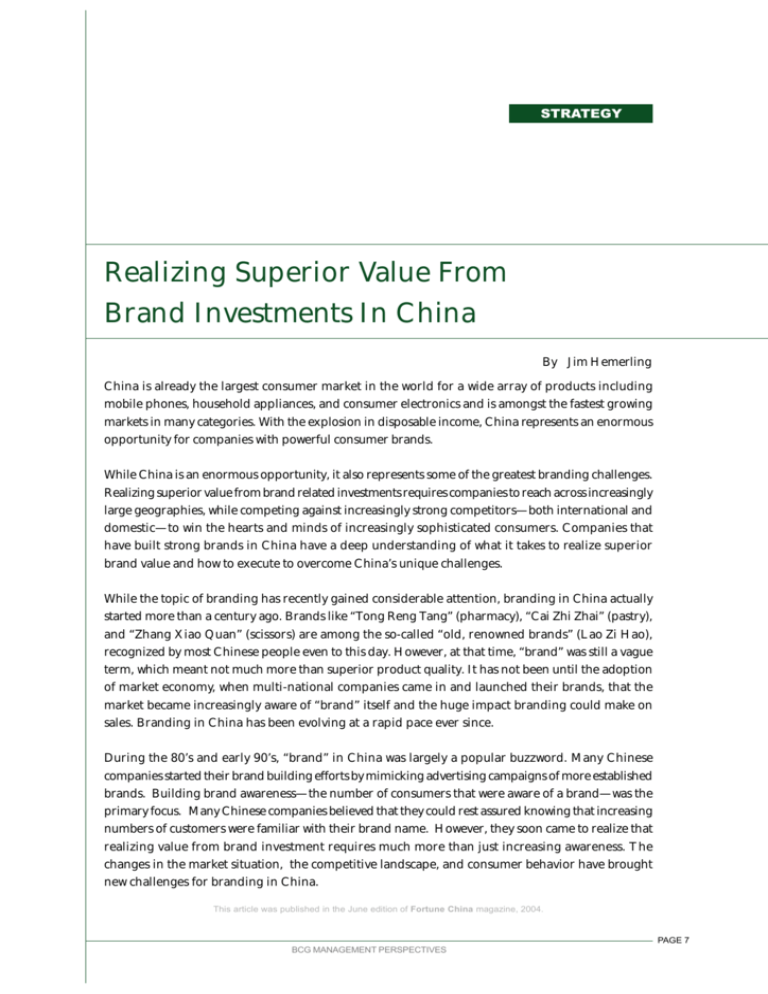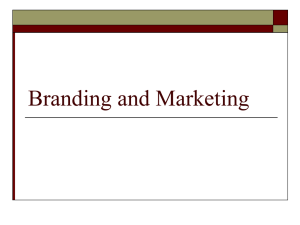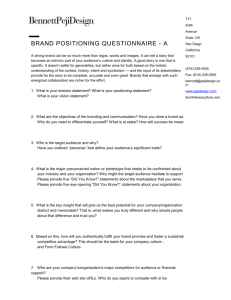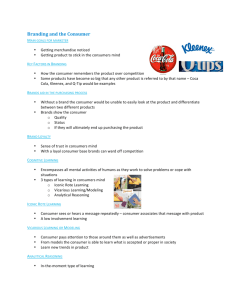
STRATEGY
Realizing Superior Value From
Brand Investments In China
By Jim Hemerling
China is already the largest consumer market in the world for a wide array of products including
mobile phones, household appliances, and consumer electronics and is amongst the fastest growing
markets in many categories. With the explosion in disposable income, China represents an enormous
opportunity for companies with powerful consumer brands.
While China is an enormous opportunity, it also represents some of the greatest branding challenges.
Realizing superior value from brand related investments requires companies to reach across increasingly
large geographies, while competing against increasingly strong competitors—both international and
domestic—to win the hearts and minds of increasingly sophisticated consumers. Companies that
have built strong brands in China have a deep understanding of what it takes to realize superior
brand value and how to execute to overcome China’s unique challenges.
While the topic of branding has recently gained considerable attention, branding in China actually
started more than a century ago. Brands like “Tong Reng Tang” (pharmacy), “Cai Zhi Zhai” (pastry),
and “Zhang Xiao Quan” (scissors) are among the so-called “old, renowned brands” (Lao Zi Hao),
recognized by most Chinese people even to this day. However, at that time, “brand” was still a vague
term, which meant not much more than superior product quality. It has not been until the adoption
of market economy, when multi-national companies came in and launched their brands, that the
market became increasingly aware of “brand” itself and the huge impact branding could make on
sales. Branding in China has been evolving at a rapid pace ever since.
During the 80’s and early 90’s, “brand” in China was largely a popular buzzword. Many Chinese
companies started their brand building efforts by mimicking advertising campaigns of more established
brands. Building brand awareness—the number of consumers that were aware of a brand—was the
primary focus. Many Chinese companies believed that they could rest assured knowing that increasing
numbers of customers were familiar with their brand name. However, they soon came to realize that
realizing value from brand investment requires much more than just increasing awareness. The
changes in the market situation, the competitive landscape, and consumer behavior have brought
new challenges for branding in China.
This article was published in the June edition of Fortune China magazine, 2004.
PAGE 7
BCG MANAGEMENT PERSPECTIVES
CHALLENGES FOR BRANDING IN CHINA
Larger geographical coverage and new sales channels: With the living standard of Chinese
people on the rise, more customers in less developed regions can afford to buy products that were
once only available in large cities. That means, to win in China, companies need to further extend
their branding efforts to cover a larger market. Given the diversity of the China market, companies
have to carefully study the diverse customer groups and tailor the branding effort to each region/
customer group. If necessary, companies may need to focus on a smaller, specific segment, rather
than a broader customer pool. Meanwhile, new sales channels (e.g. hyper-markets, convenience
chains, online shopping portals, tele-marketing etc.) and customer interfaces (SMS service, direct
mail etc.) have emerged. Each of these creates new and different purchase experiences. Companies
need to think more carefully about how to utilize them in branding to provide customers with best
possible purchase experience.
Intense competition: Based on a report issued by China State Administration for Industry & Commerce,
the number of trademark and service mark applications in 2003 reached 405,000, an increase of 26.4%
over the previous year. This reflects the proliferation of brands in China since the mid 90’s. Given
that there are more players to compete against, differentiation becomes increasingly difficult. The
same proliferation can be found in individual company’s spending on advertising. China has now
surpassed Japan to become the second largest media television advertising market in the world
behind the United States. The annual carnival of CCTV prime time TV commercial airtime bidding
is a typical example. In the 2004 public bidding, 1000 representatives from more than 150 top
companies in China squeezed into an auditorium that only accommodates 500 people to bid for
their TV commercial time on CCTV. The same amount of airtime earned CCTV 4.4 billion RMB, a
33% year over year increase. To stand out in such a crowed market, companies need to spend more
while ensuring that their media investments are being effectiveness.
More sophisticated customers: Chinese customers, particularly those in larger cities where they
have had the most exposure to a wide range of brands, are becoming increasingly sophisticated in
making their purchase decision. These consumers have much higher expectations. They do their
homework before making purchases, particularly for items that cost more. To appeal to these consumers,
companies need to provide compelling emotional and functional benefits. They need to deliver a
superior “brand experience” which includes the advertising, but places even more emphasis on the
performance of the products, the value of the sales advice, the quality of the after sales service. The
emphasis on service is especially true to industries like home appliances and automotive. Customers
now explicitly inquire about what service the manufacturers and their dealers can offer before they
make the purchase. Sophisticated consumers are increasingly placing their trust in brands that don’t
just promise great things, but actually deliver. Focusing only on advertising and making promises
will not effectively convert consumers from awareness to trial and ultimately, to loyal customer who
are willing to be “brand advocates”—telling their friends and colleagues about the benefits of the
brands they love.
Given these challenges, companies must start with a deep understanding of what it takes to realize
superior value from their brand investments.
This article was published in the June edition of Fortune China magazine, 2004.
PAGE 8
BCG MANAGEMENT PERSPECTIVES
REALIZING VALUE FROM BRAND INVESTMENTS
Branding can be an extraordinarily complex topic. Many experienced branding professionals and
company executives struggle with trying to understand what branding is really about and how to
realize value from the brand investments they are making. Different people have different perspectives.
However, to The Boston Consulting Group, realizing value from brand investments requires a systematic
approach, an approach we call the BCG Brand Value Creation Framework.
BCG Brand Value Creation Framework
Brand strategy
Brand drivers
Brand equity
Brand value
Product
Customer
understanding
Brand
positioning
Services
WOM
advocacy
Advertising
Satisfaction
Loyalty
Trial
Brand
portfolio
strategy
Price premium
Bigger volume
Brand extensions
CRM
Trust
Total
experience
Awareness
Feedback
Brand strategy: At the very first step, a company needs to craft a clear brand strategy for each brand
and for the overall portfolio of brands. It is very critical for the company to start with a deep understanding
of the targeted customers including their hopes, dreams, aspirations, needs and dissatisfactions. Because
customers are very different, it is important to segment the customers into groups that have common
characteristics. With this deep customer understanding, companies can then develop the brand
positioning which is defining the promise the company is making to its target customers.
Positioning is the art of defining how the company intends for the brand to be perceived, both
rationally and emotionally. A brand is much more than just a logo or a product. A brand is really
a promise that is made to consumers about all of the technical, functional and emotional benefits the
consumer will enjoy. Positioning is the process of defining the promise. Too many companies in
China today are focused only on product features and functional benefits. Companies that are
building powerful brands in China have made (and kept) promises that tap into a deep understanding
of consumer aspirations and motivations and have translated this understanding into promises that
really connect emotionally. This emotional connection is what enables stronger brands to develop
loyal customers who are willing to buy more and often to pay more. Some of the most loyal customers
are also willing to be brand advocates—saying good things about the brand to their families and
friends and colleagues.
This article was published in the June edition of Fortune China magazine, 2004.
PAGE 9
BCG MANAGEMENT PERSPECTIVES
If a company has several brands, then the company must also define the overall brand portfolio
strategy—how each brand will be positioned individually and how they will related to each other
and possibly to an overall ‘umbrella brand’ that unites all the brands under a shared umbrella
brand.
Brand drivers: Having a right strategy is only the beginning for brand value creation. As Sergio
Zyman, the former Marketing Officer of Coca-Cola wrote in his famous book—The End of Marketing
As We Know It, branding is to define, deliver, sometimes even over-deliver and then claim. Great
brands deliver their promises through a set of “brand drivers”.
While there are many ways to deliver a brand promise, there are typically five core brand drivers:
Firstly the product —product is an essential part of a brand, which consists of the innovation,
design, features, quality and reliability. Secondly service—when a customer buys a product, they
are also buying service during the purchase and after the purchase. Thirdly advertising—a brand
needs to convey its message through advertising in various channels to convey the technical,
functional and emotional benefits of the brand. Fourthly, customer relation management (CRM).
Attracting new customers is very expensive but if that customer can be turned into a loyal customer
that has a long-term relationship with the company, the value realized from the brand investments
increases dramatically. Customer relationship management is therefore a critical driver of brand
value. The fifth brand driver is the “total experience” that the customer has of the brand. The
total experience includes every contact point the customer has with the brand including but not
limited to the product functionality and reliability; the retail outlet layout and amenity; the
interaction with salespeople; the company hotline and any association the customer can have in
their daily life.
Each brand driver requires investment. Choosing how much to invest in total, how much to invest in
each brand driver, and how to spend the investment effectively within each brand driver is a core
brand building discipline. The best companies have deep experience, tools, methodologies and
data to enable these decisions. The ability to make wise, fact-based investment decisions is at the core
of realizing superior value from brand building investments.
Brand equity: Brand equity is a term used to define the strength of a brand. It is the result of the
investment made in each of the brand drivers. Brand equity starts with consumers being aware of the
brand. An initial level of trust will lead a consumer to try the brand and if satisfied to then build
loyalty and ultimately, become an advocate willing to tell others good things about the brand. Brands
that have stronger brand equity will attract and retain more customers thereby realizing a higher
return on the brand building investments.
Brand value: The final outcome of the brand value chain is brand value—the financial value that
comes from brand equity, which results from brand investments in each brand driver, which in turn
is guided by a clear brand strategy. Brand value comes from increased brand equity—customer
satisfaction, loyalty and advocacy—which result in increased volume from more customers buying
more products and services plus the ability to realize a higher price premiums plus the ability to
extend the brand into new products, services and customer segments.
This article was published in the June edition of Fortune China magazine, 2004.
PAGE 10
BCG MANAGEMENT PERSPECTIVES
LEARNING FROM COMPANIES THAT ARE REALIZING SUPERIOR BRAND VALUE
Many companies in China are making huge investments to build their brands but not all are realizing
superior value from those investments. Some simply have stumbled at the first step—they don’t have
the right brand strategy. Some have made the right overall strategy—they understand their customers
and have effectively positioned their brands—but they have failed to make the right investments in
the right brand drivers. Much can be learned from these companies but even more from those that
are already succeeding in China. What is it that sets these companies apart from the others?
Adapting the Brand Positioning: Adapting the brand positioning according to the China market and
the specific target segment is sometimes what it takes for a brand—especially a foreign brand—to
survive and thrive in China. Motorola is an excellent example of adapting a global brand positioning
for China.
The global brand image of Motorola mobile phones has been “Intelligence Everywhere”. This
positioning reflects Motorola’s brand promise: application of its advanced technology in the products
for customers’ needs everywhere in their lives. In China, Motorola initially defined four target customer
segments: technology oriented, time management oriented, personal image oriented and social life
oriented. This definition seemed fine at that time, as it properly covered the main customer group of
mobile users: business executives and rich small enterprise owners.
However, Motorola soon discovered that it was losing market share of the fastest growing segment:
the new generation (office workers, college and high school students etc). This generation wanted
more features and an image that captured their lifestyles, fashion taste, and personality. For this
generation, Motorola was less attractive than brands like Nokia, because they associated the brand
more with “tradition”, “technology-based” and “engineering-oriented”.
Recognizing the aspirations of this important consumer segment, Motorola launched a series of
marketing activities to re-interpret “Intelligence Everywhere” in China. Motorola began to promote
the nickname “Moto” instead of “Motorola” on the media. It labeled “Moto” as “making lives of
customers easier, smarter and fun.” Motorola invested heavily in Television and billboard media
with a wave of “Moto” ads, all centered on “cool” and “new”. Simultaneously, a new series of Moto
products were launched. V70 was the first one. It has a rotatable cover, a round display and a
transparent keypad—cool designs that are especially appealing to young people.
Motorola did not stop there. Besides churning out new models, they also aligned other activities to
create an entire brand experience that was consistent with the new positioning. For example, Motorola
organized interactive activities on its website: mobile try-outs, sports activities to customers. It also
provides personalized service to customers: synchronization of address book in mobiles with PCs,
customized bells and screensavers etc. According to a report issued by CCID Consulting on the
domestic mobile phone market, Motorola has maintained it’s market leadership position in China,
ahead of all other foreign and domestic brands.
Deliver superior products and service. The best companies put quality first. It seems blatantly
This article was published in the June edition of Fortune China magazine, 2004.
PAGE 11
BCG MANAGEMENT PERSPECTIVES
obvious: product quality counts. In China, however, manufacturing products with reliable quality is
not only a good practice, but also a major differentiator. Take the car industry as an example: Many
vehicles now coming onto the market with some quality problems. In many case rapid growth is
taxing the capabilities of both carmakers and their suppliers. The race to launch new products is
prompting many companies to take shortcuts. Many have not invested enough to establish adequate
quality-control processes—or to find the trained people to oversee these processes. In some cases,
these product quality problems are compounded by weak after-sales support.
Buyers—and particularly first-time buyers—are paying a lot of attention to this issue. Still highly
skeptical, they rely heavily on word of mouth. A single anecdote about bad quality and disappointing
service can do enormous damage to a brand’s image. A top priority, therefore, is to build cars with
reliable quality—and also to ensure that service is in place to address any quality problems quickly
and effectively.
BMW is a very good example in quality management. When it established its JV in Northern China
with Brilliance Automotive, it sent a large team of engineers to work together to make sure every
technical detail is right for the production facilities and throughout the supply base. BMW implements
the same rigorous quality control mechanism in China as it is doing in Europe and around the
world.
Product quality is critical, but it’s only the basis for successful branding. Engineering product features
toward customer needs will take the product to the next level. KFC set us a very good example. After
careful market study, KFC realized that leveraging the global “chicken-cooking expert” image was
not enough in China. It could benefit from catering to Chinese people’s diet preferences. KFC
launched a series of adapted “Chinese food” such as vegetable egg soup, Peking chicken egg
rolls, all of which were very well received by Chinese customers. KFC has also made a significant
investment—a brand building investment—to recruit, train and retain its people so that they can
deliver a service level that clearly differentiates KFC from many other local and foreign restaurant
chains in China. KFC has expanded the number of restaurant number has exceeded 1,000 in China
and in a recent TV commercial, KFC claimed that it will “take root deeply in China and be part of
Chinese people’s life”.
Build a differentiated emotional connection. For many products, consumer goods in particular,
technology is no longer an entry barrier. As a result, companies are facing numerous competitors
producing products with similar quality and features. While these companies should continue to
push for ways to provide superior products and services, the in these categories the key often lies in
increased emotional differentiation. Pepsi did exactly that to compete against Coca Cola in China.
Pepsi entered China in early 80’s. In late 90’s, Pepsi adopted “Ask for More” as its positioning in
China to appeal to the young generation. Pepsi believes that “Ask for More” echoes with the young
generation’s aspiration for the future—more independence, more freedom, more opportunities. Pepsi
used two levers to build up the brand around the positioning. Firstly it aired a series of Television
commercials featuring the most popular stars in the entertainment circle, mostly in the form of music
videos. Secondly, it used a series of marketing activities in key markets, such as sponsorship of the
This article was published in the June edition of Fortune China magazine, 2004.
PAGE 12
BCG MANAGEMENT PERSPECTIVES
China soccer league, street basketball games, campus concert etc. All of the efforts focused on young
people, Pepsi’s core target consumer. Pepsi’s brand building efforts have been rewarded as it has
successfully gained market share among young people, the prime consumer of Cola products in
China.
CREATE A SUPERIOR BRAND EXPERIENCE
Not long ago few would have thought that Chinese consumers would be willing to spend 30 RMB for
a cup of coffee. In the span of just a few years, Starbuck’s has proven again, as it has in so many
countries around the world, that a large and growing number of Chinese would be willing to do just
that. What is the magic behind the Starbuck’s brand?
As Howard Schultz, the Chairman and CEO of Starbucks explains it, “At Starbucks, our product is
not just great coffee but also what we call the ‘Starbucks experience’: an inviting, enriching environment
in our stores that is comfortable and accessible yet also stylish and elegant” ...Starbucks...is more
than great coffee. It’s the romance of the coffee experience, the feeling of warmth and community ...
that tone is set by our baristas...they’re the ones who create the magic.’
Starbucks’ strong brand position comes from the experience Starbuck’s creates by romancing the five
senses: Firstly, smell—Starbucks uses 100% Arabica beans and there is no second aroma you can
identify in any coffee Starbucks shop. Secondly, sight—every Starbucks coffee outlet gives you the
uniform scene: all of them use consistent logo, colors, furniture and artwork, all tastefully designed
to create a warm, elegant and inviting atmosphere. You can tell no difference between a Starbucks
coffee shop in Shanghai and the one in Paris. Thirdly, sound—the deliberate sound of making
espresso and metal scoop shoveling beans make you feel all is specially made for you. Fourthly,
touch—the uniformed texture of materials for cup, cup sleeve, napkins and furniture makes Starbucks
a comfortable and sociable gathering place away from work and home. Finally, the taste—100%
Arabica beans gives you an authentic Italian styled taste and its 18~24 second rule to ensure you will
have a fresh and hot coffee at any time you want it. Starbucks has proven in China, as it has
throughout the world, the value of investing to create a unique brand experience.
ORGANIZING FOR BRAND MANAGEMENT
While the companies cited above have each developed unique brands in unique ways, they all share
one thing in common: they all organize around the brand. Many companies in China are still much
more comfortable organizing around products or geographies or channels with the result that not
enough emphasis is placed on brand management across all the activities of the company. Companies
like Motorola, BMW, KFC, Pepsi, and Starbucks that have built powerful brands in China, place
brand management at the center of the company. They do not delegate branding down only to the
marketing department or to outside advertising agencies because they understand that brand strategy
development and decisions about how to invest in the various brand drivers must include all parts of
the company including R&D, product development, manufacturing, marketing, sales and distribution.
The best companies organize around the brand to ensure that there is consistency in strategy and
execution across all geographies and points of customer contact and to ensure that there is a constant
This article was published in the June edition of Fortune China magazine, 2004.
PAGE 13
BCG MANAGEMENT PERSPECTIVES
stream of innovations that are consistent with the core brand positioning. Organizing for brand
management is therefore one of the most important lessons from companies that are realizing superior
brand value.
*
*
*
Realizing superior value from brand investments in China’s complex and increasingly competitive
market will be decisive in separating the winners from the losers. Here is where the brand battle will
be won or lost. Adding capacity, reducing cost, launching new products, and extending distribution
are necessary but not sufficient. Demanding though these activities are, they cannot be allowed to
distract companies from winning the hearts and minds of China’s consumers by investing wisely to
build powerful brands.
Jim Hemerling is a senior vice president in the Shanghai office of The Boston Consulting Group.
You may contact the author by e-mail at:
hemerling.jim@bcg.com
© The Boston Consulting Group, Inc. 2004. All rights reserved.
This article was published in the June edition of Fortune China magazine, 2004.
PAGE 14
BCG MANAGEMENT PERSPECTIVES








